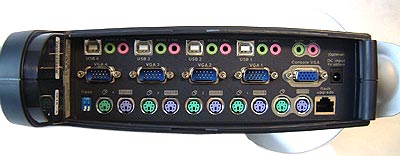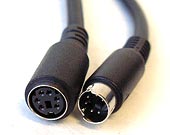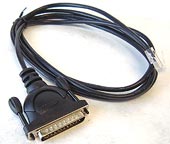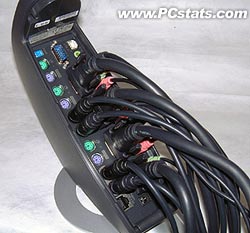Belkin have
supper charged the Omniview KVM by adding USB and audio ports in addition to the
standard set of PS/2 and video connections. The USB and PS/2 ports share the
same purpose - keyboard and mouse control, but one of the caveats of the system
is that only one set or the other may be used for keyboard and mouse control. In
other words if you use the USB connection on one slaved computers, you cannot
also use the PS/2 jacks.
| Rear of the Omniview KVM |
PS/2 cable extensions |
Cable for firmware upgrade |
 |
 |
 |
The plus to this situation is that if you have a set of
legacy computers and only a USB keyboard/mouse on hand then you're
still in luck. Plugging that USB keyboard/mouse into the KVM with the
help of the two PS/2 extension cables and some USB-to-PS/2 adaptors (which are
not included sadly) gives you control over all subsequent
legacy computers.
In our tests we used a
standard set of PS/2 keyboard an mice to control up to four computers; two were
legacy (in other words we used the PS/2 ports) and two were USB (in other words
we only had one USB cable connected to the computer). The master control for the
Omniview is based on the PS/2 standard so a USB cable cannot be directly plugged
into it unless done by the means we have already mentioned.
There is also a spare power
port, but since the unit does not ship with a AC adaptor is isn't of much use to
most of us. The unit draws power from a host machine's PS/2 keyboard or USB
port, so you cannot use it as just a video switch unless at least one computer
is hooked up via the USB or PS/2 port.

Image quality during our testing of the unit was
very good - there was almost no ghosting visible at higher resolutions, and
keyboard and mouse controls were very dependable. The unit takes a second or so
during each change to resynchronize all three signals, and in that period the
only problems we ever noticed were with the mouse. In an instance here and there
where we had the USB port controlling both mouse and keyboard the mouse
signal didn't kick over. Changing back to another signal, and then back to the
computer resolved this glitch, and realistically this only happened once or
twice with a few of the computers the Omniview has been tested on.
The Omniview allows
users to control switching via a set of four keys on the unit (with lights
to indicate which signal is on) or by hot keys from the master keyboard.
Pressing Scroll Lock twice very quickly and then the down or up key lets you
move through the four connections quickly.
Autoscan can be enabled by keying in Scroll Lock twice fast and "0". The only
thing aspect of the Belkin Omniview which I didn't like was the annoying beep
that happens each time you switch from one system to another - and there just
isn't anyway to turn it off.
Pumping stereo audio from multiple computers through to one set of speakers
is a nice feature and audio quality was excellent even at louder volumes.
As there are two stereo channels (one for speaker and the other intended for
microphone) it should be possible to pump stereo and center/sub channels through
the Omniview if you don't need the microphone feature.
